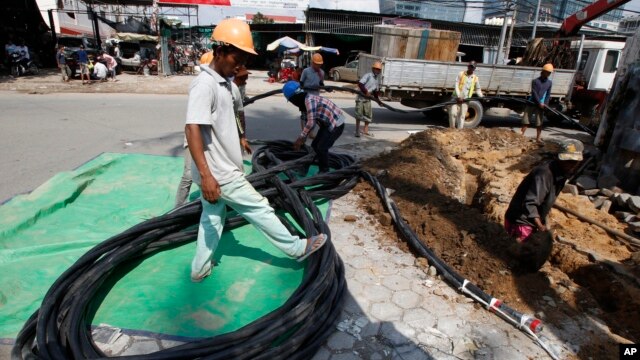By Phorn Bopha
February 05, 2015
PHNOM PENH—Not very long ago, the Toek Thla neighborhood of Phnom Penh was a land of grass and rice fields, along with a small pond. Now, it is part of the swelling Cambodian capital with markets, business centers, schools and, of course, factories.
And people. Lots of people.
Phnom Penh, with a population of 1.5 million, is one of the fastest-growing cities in Southeast Asia, adding about 500,000 people since the turn of the century. That has meant a lot of changes in a short period of time, including more congestion, more markets, more housing. And more opportunities, newcomers say.
The city is the best place in the country to find work, creating an irresistible pull for impoverished communities in rural areas. Today, the city continues to grow and people keep pouring in.
Looking for opportunity
People like Chhorn Noeun, who left central Kampong Thom province with her two sisters to find work in the capital.
“Most people in my village have come to Phnom Penh,” she said while shopping at a small business on a Toek Thla side street. “There’s almost no more people back home. People are following each other. One sees others leaving, so they leave as well.”
They come looking for opportunity, knowing that there is work to be found.
“It is very hard to do business in the province if you do not have financial resources,” Chhorn Noeun said. “Here it is OK. If you do not have financial resources, you can work for others.”
She has worked as a cleaner for a gas station since she moved to the city in 2007. In that time, her salary has gone up from $50 per month to $150 per month. That’s a lot of money in the countryside, but not so much in the big city, where prices keep rising.
“It’s costly in Phnom Penh,” she said. “One has to pay for rent, electricity, water and school fees for kids.”
In the short time she’s been in the city, she has seen it grow, as well. More buildings, more hotels, more businesses. But she said the best opportunities are not for the uneducated.
“If people are well educated, it’s easy for them to find jobs and make money,” she said. “We’re not well educated. It’s hard for us.”
She hopes to one day save enough for a plot of land in the area, so that she can build a house, like a friend recently did.
More customers, more competition
Coffee shop owner Hong Gna, who has lived in the city since 1985, said that urbanization has meant good business and income. “Before, it was a rice field and a lake here,” she said. “Now houses are everywhere.”
But there is also marketplace competition.
“I just opened my grocery shop late last year,” said Sok Lanh, also a resident here since 1985. “These last few months, I’ve seen two more shops opened,” she said, nodding to her competitors across the street. “More and more sellers have started selling, like mushrooms. People are smarter and smarter, as well. They are not that gullible anymore. More sellers and fewer buyers. It’s very competitive.”
Competition and opportunity are here, but something has been lost for some.
Dul Thavrin, a former police officer from Svay Rieng who moved to Phnom Penh to find a better job, said the growth doesn’t do much for him.
“The traffic is very bad now,” he said. “It’s hard to move around.”
As for the coffee shops and shopping centers, he doesn’t go into them, he said. “Those buildings are for the rich.”
The growth has also brought some unrest. Allegations of land grabs, evictions of the city's poor and concerns about environmental damage have sparked sporadic protests.
Bulging borders
But the growth continues all across the capital, which has also seen its physical size more than double since 2000.
Long Dimanche, a city hall spokesman, said Phnom Penh has expanded since 2000, growing from about 300 square kilometers to 700 square kilometers. It once had nine districts and now has 12. About 20 communes from adjacent Kandal province had to be carved up and added to Phnom Penh to accommodate the growth.
People leave rural areas to find work, either with the state or private companies. Long Dimanche said the population loss in the rural areas is concerning, because the country could ultimately have a shortage of farmers.
“We might lack the labor to raise cattle or do agriculture,” he said.
A recent report on global growth by the World Bank noted the rapid expansion of Cambodia’s cities. Battambang and Siem Reap are also growing rapidly, with both more than doubling in size since 2000.
This report was produced in collaboration with the VOA Khmer service.


No comments:
Post a Comment